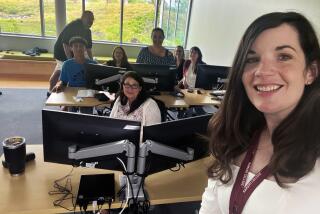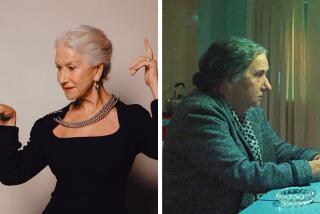‘I’ve seen reconstructions that come close to being portraiture. It’s frightening.’ : ‘Detectives’ Face Unusual Task, Bringing Bones to Life
- Share via
SAN DIEGO — Shannon Collis reads the human skull like a topographical map, searching for bumps and ridges that help her bring life to long-dead bone.
From those clues, she gives identities to the anonymous, hoping to bring some peace to families unsure of the fate of missing relatives and to help authorities close stymied investigations.
“It’s the last thing you can do for someone who’s dead, whose family is grieving--to say ‘to the best of my knowledge, this is your family member,’ ” said Collis, a 30-year-old graduate student in anthropology at San Diego State University. “I like being able to help in that process.”
Collis’ craft is facial reconstruction, a blend of science, art and detective work by which she re-creates the features worn off skulls by time and the elements. Relying on artistic training, a body of scientific knowledge and the directions that carefully trained eyes can find on bone surfaces, Collis and the country’s few other facial reconstruction specialists create faces that are startlingly real.
“I’ve seen reconstructions that come close to being portraiture,” she said. “It’s frightening.”
The field has a fine track record. Betty Pat Gatliff, who has done more facial reconstruction sculptures than anyone else in the world, has produced positive identifications in two-thirds of the 120 cases she has handled for law enforcement agencies in 25 states and Canada.
“Sometimes they look almost photographic,” Gatliff said. “But you always see things in the soft tissue that the skull just doesn’t indicate--freckles, warts.
“To me, if the family recognizes the face and says that has to be so-and-so, and then the dental X-rays prove it, that’s the name of the game.”
Founder of Skullpture Lab in Norman, Okla., Gatliff charges law enforcement agencies $500 for the “facial sculptures,” as she calls them, plus $75 for photographs and negatives of her work.
She developed some of today’s reconstruction techniques during the past 20 years, most of them while working for the Federal Aviation Administration’s Civil Aeromedical Institute in Oklahoma City. She is passing on the techniques to Collis and others by teaching seminars around the country.
Collis is a comparative rookie, with six practice reconstructions to her credit. She is working on her first two cases, reconstructing faces for the San Diego County Sheriff’s Department and for the San Diego Police Department, without pay. She declined to discuss details of the cases.
Anyone who does facial reconstruction becomes part of a small group of about 30 or 40 people nationwide practicing a craft that dates at least to 19th-Century Vienna.
Collis, who has the distinct advantage of having training in fine arts, anthropology and osteology (the study of bone), is apparently the only person doing facial reconstruction in Southern California. Four others, including two from the Sheriff’s Department and one from the Police Department, attended a seminar given by Gatliff in San Diego last week.
During a recent demonstration at the San Diego Museum of Man, Collis took special care to debunk some of the miracle-worker impressions that may have been created by facial reconstruction in the movie “Gorky Park” and episodes of “Quincy,” for which Gatliff worked as a consultant.
Facial reconstruction “cannot be used for a positive identification,” Collis said. Only fingerprints or dental X-rays can be considered by authorities to be conclusive evidence of identity.
Collis recalled a visitor to one of her demonstrations who nudged his wife and said: “See, they can reconstruct a whole body from a tiny bone fragment.”
“He’s been watching ‘Quincy,’ ” Collis said.
Facial reconstruction is also a technique of last resort because it is complex and inexact. “It’s a last ditch. It’s used when you’ve run out of possibilities,” Collis said.
To begin, Collis needs three essential pieces of information: the age, race and sex of the person she is trying to identify. Determining age is the toughest, for a skull yields few definitive clues.
Tooth wear and loss, deterioration of bones above the teeth, and the pattern by which a skull is knit together provide some general information, but to pinpoint age within a few years, Collis examines the pubic bone if it is available. The wear on facets of the bone can fix age within a few years.
“In determining age, the skull wouldn’t be your first choice, unless it’s a juvenile, because you can tell (from) tooth eruption,” she said.
Sex and race are easier to ascertain. A male has a rougher “occipital protuberance,” a small hook of bone to which heavy muscles are attached, on the back of his head. Female heads are smoother in the rear, but they have round knots of bone, called “cranial bossing” at both sides of the forehead, Collis said. Men also have heavier ridges above their eyebrows.
Sex is also easier to divine if other bones are available, Collis said. Women are generally smaller and lighter than men, and they have wider pelvic bones.
Race is determined largely by the shape of the skull. Caucasians have flat “straight-up-and-down faces” and blacks are recognizable by a wider nasal aperture, Collis said. Asians and American Indians are identifiable by a shovel-shaped incisor.
After pegging all those factors to the extent possible, Collis turns to a manual of “average tissue depth” charts developed by a New Mexico researcher who measured the amount of flesh on the faces of hundreds of cadavers. The averages are divided into three categories for “emaciated,” “normal” and “obese” people, information useful to Collis if bones or clothing pinpoint the approximate size of the decomposed body. If those clues are not available, Collis assumes the person was of normal size.
Using slim rods made of a pink, rubbery material like the kind found in pencil erasers, Collis cuts short pegs equal to the average tissue depths at 32 separate points on the skull’s face. She glues the markers to the appropriate parts of the skull.
Prosthetic eyes are set into the skull’s orbits, positioned so that they don’t protrude, and aligned vertically with the canine teeth.
From there, facial reconstruction becomes a skilled, artistic exercise in connecting the pegs with modeling-clay “flesh.” Collis applies clay above the eyes, then below the jaw, and around the mouth.
It is not as easy as it sounds. It takes a sculptor’s talent and an anatomist’s knowledge to fashion and attach nose, mouth and ears at their precise locations. Ears, for example, should be set at a 15-degree angle to the head; eyelids should cover the tops of the irises.
Some features virtually shape themselves, based on the cues provided by the bones. The nose can be fashioned almost exactly, its width determined by the width of the nasal opening and its projection by the length of the nasal spine. Collis recalled reworking one huge proboscis several times, unable to believe that the bone structure was telling her to build one that large.
“The nose, in my opinion, is the easiest feature to do,” she said. “You get more information about the nose from the skull than any other feature. The ears, for example, are pure guesswork.” With no bones to guide ear construction, the best Collis can do is set the width, length and shape from the size of the opening.
But the skull does provide strong evidence of facial contours. By remaining faithful to its shape and applying an artist’s touch where necessary, very accurate likenesses can be produced, Collis said.
“After you set the features and begin to smooth the features, . . . the face just starts to come out,” she said. “This face just comes out on its own. You don’t want to get too innovative.”
Finally, the skin is roughed with sandpaper to take off the clay’s shine, and a neck and shoulders may be shaped. A wig or clothing may be added before photographs are taken for distribution to the media. The entire process takes three or four eight-hour days.
More to Read
Sign up for Essential California
The most important California stories and recommendations in your inbox every morning.
You may occasionally receive promotional content from the Los Angeles Times.










